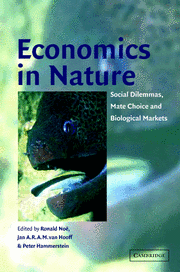Book contents
- Frontmatter
- Contents
- List of contributors
- Preface
- Acknowledgments
- 1 Games and markets: economic behaviour in humans and other animals
- Part I Economic behaviour in social networks
- Part II Biological markets
- 5 Biological markets: partner choice as the driving force behind the evolution of mutualisms
- 6 The utility of grooming in baboon troops
- 7 The cleaner fish market
- 8 Modelling interspecific mutualisms as biological markets
- Part III Mating markets
- Index
8 - Modelling interspecific mutualisms as biological markets
Published online by Cambridge University Press: 04 August 2010
- Frontmatter
- Contents
- List of contributors
- Preface
- Acknowledgments
- 1 Games and markets: economic behaviour in humans and other animals
- Part I Economic behaviour in social networks
- Part II Biological markets
- 5 Biological markets: partner choice as the driving force behind the evolution of mutualisms
- 6 The utility of grooming in baboon troops
- 7 The cleaner fish market
- 8 Modelling interspecific mutualisms as biological markets
- Part III Mating markets
- Index
Summary
Introduction
Mutualistic interactions between species are diverse and widespread, and are becoming well documented empirically (Bronstein 1994b). The partners involved in mutualistic interactions range from bacteria to fungi to plants and animals. Early mathematical models of mutualisms predicted that they should be rare in nature (e.g.May 1973). Since then, modellers of mutualisms have focused on defining conditions and mechanisms that could account for the prevelance of mutualistic interactions in nature. Recently, mutualisms have been modelled as biological markets (Noë & Hammerstein 1994, 1995; Schwartz & Hoeksema 1998).
Mutualisms are characterised by complexity and variation, with multiple, varying individuals and species on both sides of the interaction, species engaged in multiple types of mutualism simultaneously, and costs and benefits of the interaction changing over time and space. Biological market models address this complexity in a number of ways, and as such may be appropriate for modelling many types of mutualistic interactions. The central mechanism of market models is that the price of trade is negotiated, with individuals choosing partners who are offering the best price. This partner-choice mechanism incorporates variation among potential partners in a mutualism, and recognizes that mutualisms operate in a complex community context.
Many mutualisms may be best seen as interactions in which individuals of one or both species exploit individuals of the other species, but that none the less result in net benefits to each of the individuals involved (Thompson 1982; 1994; Futuyma & Slatkin 1983; Janzen 1985; Herre & West 1997).
- Type
- Chapter
- Information
- Economics in NatureSocial Dilemmas, Mate Choice and Biological Markets, pp. 173 - 184Publisher: Cambridge University PressPrint publication year: 2001
- 11
- Cited by



